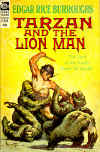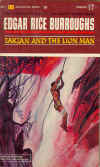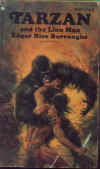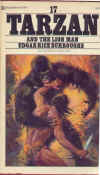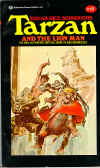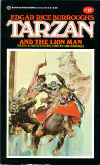Penguin Dictionary Of Symbols p. 306
Doubles. In every culture artists have
depicted double-headed creatures, SERPENTS, DRAGONS, BIRDS, LIONS, BEARS
and so on. This is due neither to mere love of ornamentation nor
to some Manichean influence, the creatures so depicted all have a bipolarity,
both benign and malign, and this is described in their individual entries
in this dictionary. It is very likely that it is this double aspect
of the live creature which is suggested by its depiction with two heads.
For example, the lions strength symbolizes both sovereign power and a consuming
lust, whether if be for justice, or for the exercise of absolute authority
in a bloodthirsty tyrant. Similarly, ribbons or wreaths depicted
round a person's head may symbolize, if they form a CLOSED circle, confinement
in difficulty an misfortune, but if broken, release.
Sometimes duplication serves merely to re enforce
and redouble the meaning attached to one of the POLES of the symbol.
Traditional religions generally thought of the
soul as being the double of the living owner, able to leave the body at
death, in dreams or through magical practices, and to return to the same
or some other body. Mankind thus provided its own self-portrait in
duplicate. In any case, instances of hysterical or schizophrenic
duplication of personality are well known to psychotherapy.
German Romanticism endowed this notion of a person's
double (Doppelganger) with tragic and fatal overtones....It may sometimes
be our complement, but it is more often the foe with whom we are lured
to fight....In some ancient traditions, meeting one's double is an unlucky
occurrence, and is sometimes even a presage of death.
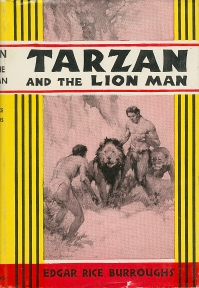 Lion Man is overwhelmingly a novel of doubles or duplicity. The
number of things doubled is bewildering. I deal only with the most
obvious here. The reason Burroughs concentrtes on doubling, I believe
is because he discovered the double meaning of the terms of the contract
he signed with MGM. He was stunned by the duplicity.
Lion Man is overwhelmingly a novel of doubles or duplicity. The
number of things doubled is bewildering. I deal only with the most
obvious here. The reason Burroughs concentrtes on doubling, I believe
is because he discovered the double meaning of the terms of the contract
he signed with MGM. He was stunned by the duplicity.
On p. 154 Burroughs comments on duplicity such
as he found at MGM. Remember he names them BO (Body Odor) Studios
in the novel.
Tarzan was
suspicious. He saw a trap, he saw duplicity in every thing conceived
by the mind of man.
Thus having been betrayed Burroughs is now alert
seeing doubling or duplicitness everywhere.
St. John, the illustrator of the book also
picked up on the aspect of doubling. This novel was so extrememly
important to Burroughs, he even issued it on his birthday, September 1st,
1934, that he asked St. John for something different for a jacket illustration.
St. John concentrated on the Obroski/Tarzan doubling, producing a Janus
like cameo of Tarzan/Obroski facing in opposite directions.
As in the Penquin definition representing both characters of the Lion Men
Tarzan and Obroski.
In this case the two faces represent the earlier
cowardly Burroughs who has to die and the strong masterly Tarzan figure
Burroughs wishes to be.
Thus, before considereing the story it would
be fruitful to examine ERB's use of doubling and confusion of reality,
or in other words craziness, madness or insanity.
It is obvious that when ERB is passing through
a period of extreme stress Tarzan loses his memory and/or doubles - that
is to say splits his personality in a hysterical or schizophrenic way.
At this point in his life Burroughs is enduring the stress of sexual conflict
- the change in affections from Emma to Florence - as well as the extreme
stress of having lost control of his creation and actual alter ego to MGM
as representatives of his Judaeo-Communist enemies. In point of fact,
as Burroughs may have realized, the battle, even the war, was lost.
As MGM's 1936 movie, Tarzan Escapes, indicates Tarzan/Burroughs
had been captured. Hence the tenuous grasp on sanity in this book.
In Burroughs' mind and in fact he had been
trapped by duplicity, itself a form of doubling. When Tarzan, having
climbed the Stairway to Heaven finds the front door standing open he scents
a trap but as his intention was to enter anyway he enters. He is
now only in the antechamber of fate be could still back out. He notices
six doors of which of which Door #3 is accessible. He does try the
other five doors but they are locked. Entering Door #3 he begins
the descent of a dark stairwell. He encounters another door.
Rather than checking the door first he merely enters to have the door click
shut behind him. The wall is smooth, there is now no way out.
This scene may well be a fictionalized account
of his negotiations with MGM. The Studio, perhaps representing Door
#3 was offering him a contract which no other studio, doors 1,2,4,5,6 was
willing to do. Granted not everyone can spot a sterling opportunity
that is staring them in the face but it does seem odd that no other studio
was interested in a proven character. After all Twentieth Century-Fox
was working Charlie Chan movies hard and doing well. But all doors
were closed to Burroughs/Tarzan except Door #3, MGM. Not a bad thing
on the surface of it as MGM was far and away the best Studio in Hollywood.
So Burroughs entered into negotiations with
MGM in the same manner as Tarzan descended dark staircase in which he couldn't
see very well i.e. Burroughs didn't understand the clauses.
Like Tarzan ERB didn't exercise caustion and while the door snapped shut
trapping Tarzan so Burroughs signed the contract which he represented as
the prison Tarzan found himself in.
The reader may find the above farfetched but
remember the first third of the story is an account of MGM's Trader Horn
expedition that he ridicules. This book is about MGM.
Before dealing with the main doubles of the
story let's consider the story within the story - a form of doubling itself.
We have God on Earth doubling God in Heaven. This becomes the source
of many jokes. Stress or no stress Burroughs doesn't lose his sense
of humor. God's castle is known as Heaven thus doubling Heaven.
The Stairway to Heaven doubles Jacob's Ladder thus calling to mind the
biblical story. Tarzan then doubles Jacob. That's just part
of sly old Burroughs' humor.
God himself has created a parallel universe
doubling England, London and the Thames. Thus the gorilla plateau
is called England while they live in London on the Thames River.
Thus a doubling of Africa and an island off the coast of Europe.
Just as God in Heaven in the biblical story
created Man so God in this story has hybridized gorillas into a new species
of gorilla men. The hybrid gorillas are doubles of both gorillas
and men while God is a double of man and gorilla.
In this dizzying array of doubles the gorillas
are not just a doubling of men but a doubling of the fifteenth century
court of Henry VIII of England. They have been altered by the use
of deathless genes or, actually, DNA, which was unknown to Burroughs at
the time but the nature of which he dimly perceives. The DNA has
been inserted or spliced into the genes of the gorillas, thus the gorilla
Henry VIII is actually Henry VIII. The Fifteenth century is doubled
in the twentieth century while the political scene of the twentieth duplicates
that of the fifteenth. ERB here may be influenced by Mark Twain's
The
Mysterious Stranger with his notion of ascending and descending staircases
of time.
During this phase of the story within the story
Tarzan is actually himself while posing as or doubling Stanley Obroski
thus actually being self contained twins; in other words the personality
formerly split between he and and Stanley Obroski is reunited with Tarzan
dominant. Thus Tarzan redeems Burroughs' former shamed self.
At this moment Stanley is dying of fever and when he does the double disappears
leaving Tarzan or Burroughs then undivided. The dead body of Obroski
is shipped back to the States while Tarzan remains in the jungle.
The story within the story is a stunning achievement
whose genius has gone unrecognized.
Doubles
And Insanity ~ Part 2.b.
The most obvious examples of doubling is the
main characters. As incredible as it may seem not only are Tarzan
and Stanley Obroski so close they can't be told apart but so are the female
leads Naomi Madison and Rhonda Terry.
I'm sure there are doubles I'm missing here
but even Tom Orman, the Director, is a double of himself when he's under
the influence of alcohol. Drunk he becomes a different Tom Orman
than when sober. Obroski himself is two people. An errant coward
when he has time to think he becomes ferociously brave when his back is
against the wall and there is no time for reflection.
Naomi Madison who has become a prima donna
or an artiste was at one time a waitress in a cheap restaurant which role
she is forced to assume again which is another form of doubling.
Also this movie Tarzan is a doubling of the
literary Tarzan so both Obroski and Tarzan are doubles of Johnny Weissmuller
who played the MGM Tarzan. As Burroughs suggests in this novel he
was half out of his mind by the terrific stress. The stress did produce
however a terrific novel.
It would seem that Burroughs was Tarzan and
Obroski as twin aspects of his own Animus while Naomi and Rhonda represented
twin aspects of his Anima. Naomi obviously represents Emma while
Rhonda is an extension of La of Opar combined with Florence. Naomi
disappears from the story apparently replaced by Balza, The Golden Girl,
while Burroughs marries Rhonda to Orman.
As regards the doubling of Tarzan who is actually
a double of Burroughs himself, Bibliophile David Adams has emphasized that
Tarzan usually views from above so that it might be the time to look into
this aspect of the character. In Lion Man Obroski is captured
and held prisoner by Rungula chief of the Bansuto. This whole scene
of Obroski with the Bansuto is one of the numerous variations of the theme
of Burroughs humiliation by John the Bully.
Burroughs was plagued with the dream, as he
notes frequent among dreamers, of going naked in public. It is a
frequent dream because multitudes of people have suffered similar humiliations
as his.
ERB has Obroski stand before Rungula who demands
his clothes, in other words his defensive and offensive armor, that without
which Obroski is exposed defenseless to the world, he loses his 'front.'
John has symbolically stripped young ERB. Burroughs describes his
humiliation in excruciating detail as Obroski does a virtual striptease.
First his shirt on down until Burroughs makes a joke of his gaily printed
boxer shorts. While the Bansuto would not have understood the signficance
of the shorts ERB takes a certain pleasure in humliating himself further.
To cover his nakedness Obroski pleads for the proverbial fig leaf and is
given a skimpy dirty g-string. Thus when he is led out for torture
he fights the Bansuto naked but in a Tarzan guise. Heck, Tarzan,
who is not civilized in the jungle, walks around naked anyway. Although
the natives themselves are naked Obroski is civilized while they are savages.
Having been subdued Obroski is lain before Rungula. By this time
Tarzan is in a tree, apparently planted there for his convenience.
He looks down on Obroski in amazement to see a replica of himself.
P. 104
In the light
of a new day Tarzan of the Apes stood looking down upon the man who resembled
him so closely that the ape-man experienced the uncanny sensation of standing
apart, like a disembodied spirit, viewing his corporeal self.
What Burroughs is describing here is the splitting
of the personality. He may have the correct sequence, first the stripping
of armor - i.e. emasculation and then the disembodiment. This theme
runs all through his work although this is his most exact and detailed
description.
Obroski has been led out to be tortured to
death and eaten by Rungula the cannibal chief. Usually Tarzan is
placed in an arena to fight one or more wild beasts. In a normal
confrontation Obroski is a coward which is to say he is unable to defend
himself. In other words his subconscious mind has been conditioned
to accept the dominance and authority of the oppressor. In still
other words in a state of terror his subconscious had been accessed to
accept certain hypnotic suggestions. But, with his back to
the wall his instinct of self-preservation overrules the hypnotic suggestion
and he fights like the proverbial cornered rat.
In this instance he used his full potential
to fell a whole battalion of Rungula's men, performing authentic Tarzanic
feats like lifting men above his head casting them among his foes.
At the time Tarzan is looking down at him he has finally been subdued lying
at Rungula's feet.
You know where I'm going, don't you?
Right. That street corner in Chicago where John the Bully confronted
young ERB. Burroughs didn't fight like a berserker though, he ran.
(Chief Run-gula?) But that was when he split his personality being
able to look down on his corporeal self like a disembodied spirit.
As the Penguin Dictionary says:
instances of hysterical or schizophrenic duplication of personality are
well known to psychotherapy. There are many examples of this phenomenon.
Here are a couple to show how it works.
When a person is enduring an unbearable situation
in which he is powerless to resist, rather than believe the situation is
happening to him he does split off a psychological projection of himself
as a disembodied spirit who sympathetically views his now alter ego's humiliation.
For instance, when Jean Genet , the author
and playwright, was at the Mettray Reformatory he was caught out by a gang
of homosexuals and gang raped. As the rape progressed, escape being
impossibe while becoming so unbearable for him, to retain his sanity he
split off a projection, a disembodied spirit. if you will, that floated
above the scene. Thus Genet was able to actually observe his rape
without participating in it. As he watched he muttered 'Poor Jean,
poor, poor Jean.' Thus the mind provides a somewhat feeble defense
but one that allows one to keep one's sanity after a fashion.. Of course
the hypnotic suggestion from this terrifically shameful event caused him
to reliquish his will to the oppressor, part of the deal to keep his sanity.
Genet's character was changed for life; he became a homosexual who had
no will to resist that of men while becoming an active agent in his future
degradation. He was always able to rationalize his actions so they
seemed right.
I will use my own experience as a second example.
In kindergarten the elite group forced a confrontation with me in which
they lost and looked bad. Circumstances removed me to a different
school before they had a chance to retaliate on me. But, then in
second grade I was returned to that school. At that point they were
waiting for me. This situation is more analogous to Burroughs than
Genet but all three incidents involve a rape of the mind which is what
emasculation is.
The general consensus is that my and Burroughs
situations are normal, they hapen to everyone. Perhaps. And
everyone reacts in their individual way but everyone reacts. A few
years later and I would have been able to handle this situation without
a problem as would have been true with Burroughs. Remember with Burroughs
however that while John the Bully only threatened him in 1884-85 fifteen
years later in a similar to identical situation he had his head broken
thus reinforcing the original situation.
In my case the situation formed my central
childhood fixation as did Burroughs. My subconscious was opened to admit
certain hypnotic suggestions which were fixed in my subconscious.
It then closed but refused to allow me to remember which of course is why
the situation became a fixation, or suggestion I could not refuse to observe.
At recess in the second grade a group of, shall
we say, twelve formed a semi-circle around me. Like Burroughs
I am compelled to make excuses for myself. For the previous
year I had been shuttled between foster homes and thus I had no support
or defense. I was alone. In kindergarten the boy, the leader
of the pack, had ordered two new kids, the first Negroes in the school,
to sit on the sandbox and not move during recess. I took the Blacks'
side offering to fight the leader. He, standing at point, declined
combat stepping back into the support of his crowd gathered behind him.
That was his mistake. He and his crowd had realized this. Now
in the second grade the boy still refused to challenge me individually.
Now they formed a sem-circle around me while their leader stood at keystone,
still enveloped by his gang so that, I presume, they could fall on me if
I resisted.
They all beamed hatred and contempt at me.
I was unable to resist the projected hatred of the boys and girls while
at this date having only the vaguest or no notion of what I was guilty
of. I was ordered to take a step forward which to my eternal shame
I did. In midstep I was ordered to stop and stay in that suspended
step throughout recess. To my shame, I did. He said:
You're going to have to be our nigger now. The shame killed my personality,
my identity , my ego. I assumed the role of 'nigger.' Terror
opened the way to the subconscious and the suggestion, you are a nigger,
among others was entered. Like Jean Genet a projection of myself
arose above to say something like: Poor kid, poor, poor kid.
The suggestion was so horrific to me that I
immediately forgot it or, perhaps since that ego died the incident was
not part of the life of the survivor. The memory was accepted and
encysted in my subconsicous, what Freud and Jung would call the unconscious.
I not only forgot the situation but I forgot the faces and names of the
kids involved. I could not remember them from that day forward although
I could talk to them as though I did know them.
The consequence was that I had to do what I
was told to do by nearly anyone. Much the same as Burroughs who wrote
a medieval story, of which he knew nothing, at the suggestion or
command of Metcalf and wrote Son Of Tarzan, which he later regretted,
and Ant Men at the suggestion or command of Bob Davis. Burroughs
became a variation of the dependent personality as did I.
On the one hand my conscious mind understood
the proper means of defense but as I began to do so my subconscious mind
overruled or shoved my conscious mind aside and obsequiously obeyed.
This plight was only changed when I succeeded
in integrating my personality in the year or so around forty-two.
That is to say the subconscious contents of my mind centered around the
cyst of my central childhood fixation was made manifest to my conscious
mind allowing the subconscious to be integrated into consciousness.
Where the 'Id' was Ego shall be, as Freud put it.
Burroughs in Lion Man at fifty-eight
is describing the same situation as that experienced by Genet and myself,
but in a different way. Like myself and Genet he would have been
easy to direct. So at that age he had not yet exorcised that particular
demon. As ERB kills Obroski off in this novel assuming both identities
while discarding that of Obroski, returning the corpse to Hollywood, becoming
solely Tarzan of the Apes one wonders if he succeeded in integrating his
personality at that point. That is what he is describing.
His experience with John the Bully, the splitting
of his personality explains why Tarzan observes from above rather than
as a participant on the ground. In Lion Man perhaps agitated
by the movie duplicate of the literary Tarzan he brought the situation
of John the Bully to consciousness, Rungula the Bansuto taking John's place
while the aspect of Tarzan or his split off alter ego watches from above
while Obroski fought like a berserker on the ground but was overcome by
numbers or in the John situation, size.
Thus Tarzan spies on the safari from the trees
by day while walking through the camp at night. Having dealt with
his humiliation in some way in Rungula's village, when Orman and West are
threatened by a lion Tarzan plummets from his tree to kill the lion on
the ground then without a word vaults back into the tree. Orman and
West mistake him for his lookalike Obroski. Thus we have the beginning
of the reuniting of the split personality which will continue in the Heaven
of the gorilla god.
Burroughs was under such extreme stress from
both his sexual desires and the MGM betrayal that he must have felt half
mad. While he and Rhonda are captive in Heaven he says: Sometimes
I think I must be dreaming. A statement that seems to be out of character
for the Big Bwana. The scene might be interpreted as ERB's Anima
and Animus being imprisoned while on one level God might represent MGM.
Tarzan comes into contact with both women as
aspects of his Anima while both of them confuse him with Stanley Obroski
which Tarzan finds amusing and lets them do. Both women pinch themselves
to see if they are dreaming or mad as well they might. Tarzan rejects
Naomi which must have confused her as she and Obroski were in love with
each other. Having ditched Naomi Tarzan/Obroski goes back for the
wise cracking Rhonda.
Then too Burroughs actually describes Tarzan
as a madman at one point. This would be tantamount to describing
himself as mad. Indeed the whole novel centers on mad or insane happenings.
The madness or insanity would be as aspect
of Tarzan's viewing from above as a disembodied spirit. The splitting
off of the aspect from his and ERB's personality would be the result of
the extreme stress of the moment that produced the feeling of dizzying
madness.
Burroughs handling of this stress in what I
consider a very extraordinary novel is absolutely masterly. I can't
think of a finer science fiction story than the story within the story
of God's in his Heaven all's wrong with the world
As a postscript to this section
a moment with the eternal question of how big the gigantic ape-man was.
Burroughs has already described him as 6'0'' in Tarzan of the Apes and
6'3" in Tarzan And The Ant Men. In this story Tarzan and Obroski
are so identical one can't tell them apart. Rungula the Bansuto is
astonished by the immense size of Stanley. He lines his tallest warriors
up alongside and Obroski towers over the tallest. We're beginning
to talk tall here.
Rungula's Tallest warrior
judging from the movie Trader horn had to beat least 6'3" so for Obroski
to tower over him he had to be a minimum of 6'8" or 9". There's no
two ways about it. Tarzan must have chosen these tree limbs he walked
to the end on without bending extremely carefully. In Leopard Men
he misjudged suffering the consequences.
On the other hand Tarzan
may be as tall as his creator needs him to be at the moment.
ADDENDUM
David Adams who
had an advance copy of this piece brought up the point that perhaps Tom
Orman in his drunken state was a comment on Emma's drinking problem.
A scenario instantly suggested itself.
Imagine Orman in his
drunken state as a peronification of John Barleycorn. Imagine sweet
sober Naomi as Emma in her sober state and Obroski as Burroughs in his
non-Tarzan, actually, Obroski state.
John Barleycorn claimed
Emma as his own as Orman claimed Naomi. Barleycorn is a jealous man
and won't tolerate Burroughs as a lover of Emma. So the couple have
to sneak a moment or two when John Barleycorn isn't around. In other
words Emma is sober.
As Burroughs fictially
represents the situation Obroski/Burroughs is visiting Naomi/?Emma in her
tnet. They appear to be in love and accord. Orman is drunk
in his tent and isn't expected to be abroad. Then Obroski hears the
drunken Orman approaching the tent. Unable to stand upt to
Orman Obroski absequiously flees.
So in real life Burroughs
and Emma are getting along fine until Emma hits the bottle conuring up
John Barleycorn. ERB can't compete with the bottle while Emma Becomes
verbally abusive under the influence just as Orman used the lash on bearers
while drunk. ERB can't take it so like the bearers he vanishes into
the night.
I think it may be a viable
scenario although obviously ERB's version.

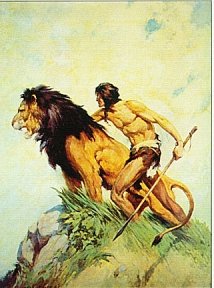
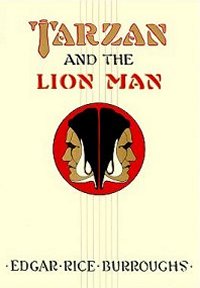
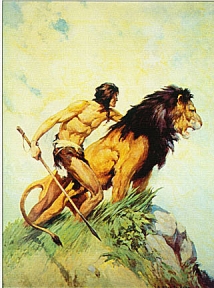
![]()
 Lion Man is overwhelmingly a novel of doubles or duplicity. The
number of things doubled is bewildering. I deal only with the most
obvious here. The reason Burroughs concentrtes on doubling, I believe
is because he discovered the double meaning of the terms of the contract
he signed with MGM. He was stunned by the duplicity.
Lion Man is overwhelmingly a novel of doubles or duplicity. The
number of things doubled is bewildering. I deal only with the most
obvious here. The reason Burroughs concentrtes on doubling, I believe
is because he discovered the double meaning of the terms of the contract
he signed with MGM. He was stunned by the duplicity.
